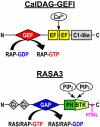RAP1-GTPase signaling and platelet function
- PMID: 26423530
- PMCID: PMC4707086
- DOI: 10.1007/s00109-015-1346-3
RAP1-GTPase signaling and platelet function
Abstract
Platelets are critical for hemostasis, i.e., the body's ability to prevent blood loss at sites of vascular injury. They patrol the vasculature in a quiescent, non-adhesive state for approximately 10 days, after which they are removed from circulation by phagocytic cells of the reticulo-endothelial system. At sites of vascular injury, they promptly shift to an activated, adhesive state required for the formation of a hemostatic plug. The small GTPase RAP1 is a critical regulator of platelet adhesiveness. Our recent studies demonstrate that the antagonistic balance between the RAP1 regulators, CalDAG-GEFI and RASA3, is critical for the modulation of platelet adhesiveness, both in circulation and at sites of vascular injury. The RAP1 activator CalDAG-GEFI responds to small changes in the cytoplasmic calcium concentration and thus provides sensitivity and speed to the activation response, essential for efficient platelet adhesion under conditions of hemodynamic shear stress. The RAP1 inhibitor RASA3 ensures that circulating platelets remain quiescent by restraining CalDAG-GEFI-dependent RAP1 activation. Upon cellular stimulation, it is turned off by P2Y12 signaling to enable sustained RAP1 activation, required for the formation of a stable hemostatic plug. This review will summarize important studies that elucidated the signaling pathways that control RAP1 activation in platelets.
Keywords: GTPase; Platelets; RAP1; Signaling; Thrombosis.
Figures



References
-
- Stegner D, Nieswandt B. Platelet receptor signaling in thrombus formation. J Mol Med. 2010;89:109–121. doi: 10.1007/s00109-010-0691-5. - PubMed
-
- Kim C, Ye F, Ginsberg MH. Regulation of integrin activation. Annu Rev Cell Dev Biol. 2011;27:321–345. doi: 10.1146/annurev-cellbio-100109-104104. - PubMed
-
- Wei AH, Schoenwaelder SM, Andrews RK, Jackson SP. New insights into the haemostatic function of platelets. Br J Haematol. 2009;147:415–430. doi: 10.1111/j.1365-2141.2009.07819.x. - PubMed
-
- Jackson SP. Arterial thrombosis--insidious, unpredictable and deadly. Nat Med. 2011;17:1423–1436. doi: 10.1038/nm.2515. - PubMed
Publication types
MeSH terms
Substances
Grants and funding
LinkOut - more resources
Full Text Sources
Other Literature Sources

